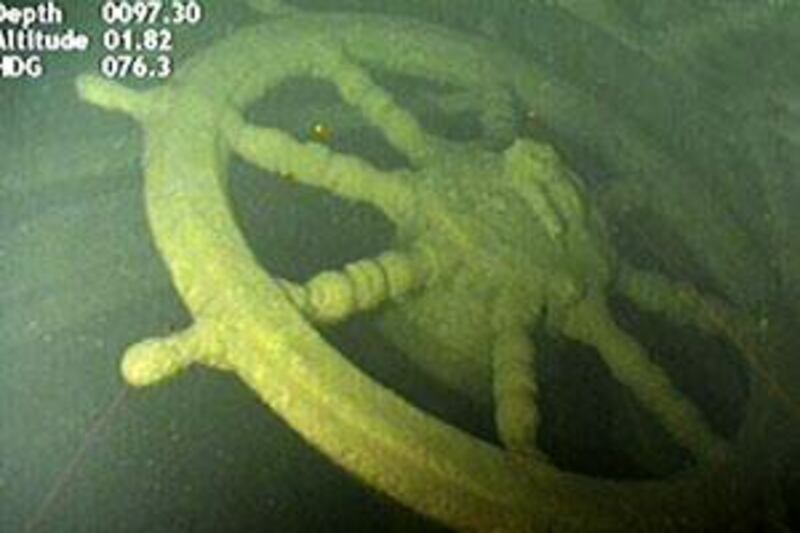BERLIN // Marine surveyors exploring the Baltic seabed for a pipeline project have discovered 12 shipwrecks believed to date as far back as the 12th century, at least one of which contains several barrels of mystery cargo. Nine of the ships, found off the Swedish island of Gotland, have been classified as ancient monuments because they are more than 100 years old. "They are of great historical interest. Three of them still have intact hulls, which is very unusual," said Peter Norman, an archaeologist at the Swedish National Heritage Board.
The Baltic Sea has some of the busiest shipping routes in the world and its seabed is a graveyard for thousands of ships, many of them well preserved because the Baltic is less affected than other seas by shipworms, wood-eating clams that destroy submerged timber. The northern Baltic where the 12 wrecks have been found has no shipworms at all. The wrecks have also been protected because they lie at a depth of at least 100 metres, where the water is fairly static due to a lack of currents.
"We think two of the wrecks could be from medieval times, from the 12th century to the 15th century, but that's still a qualified guess at this stage," said Mikael Fredholm, an archaeologist at the Swedish Maritime Museum. "Seven are from the 16th to the 18th centuries. They are mostly merchant ships. We haven't seen any ship that is clearly a naval ship." The wrecks were discovered by MMT, a Swedish company scanning a 2km wide channel of the seabed with sonar and cameras attached to diving robots for Nord Stream, the consortium building a 1,200km pipeline to pump gas from the Russian port of Vyborg to Greifswald in eastern Germany.
MMT passed on sonar and film images of the wrecks to the Swedish Maritime Museum, which has been analysing them over the last few months. Contrary to earlier reports, none of the ships is a Viking longboat, said Mr Fredholm. "On the possible medieval wrecks you can see planks and what may be cargo. One ship had four or five barrels but with unknown content," he said. No diving expedition was planned in the near future, Mr Fredholm added. "It would be interesting to go down and do a full investigation but right now the only plan we have at the Maritime Museum is to analyse those video films. We may then take the decision to go further."
The most intact wreck is a three-masted sailing ship from the late 19th century. It is 45 metres long and standing upright. Mr Fredholm said he was not worried that looters might disturb the vessels because they were too deep for most divers. Maritime experts say the waters off Gotland are likely to contain a large number of especially old wrecks because the island was an important trading hub during the time of the Vikings and in the Middle Ages.
Sweden's most famous maritime discovery so far is the Vasa, a royal warship which sank in 1628 just outside Stockholm harbour after sailing just 2km on her maiden voyage. She was salvaged in 1961 and now stands almost fully intact in the city's Vasa Museum. Nord Stream has assured the Swedish authorities that the construction of the pipeline will not affect any of the wrecks, said Tora Leifland Holmstrom, a spokeswoman for the company. The ships are outside Swedish territorial waters but inside the country's 370km economic zone.
"We had already investigated the exact pipeline corridor and we knew there were no shipwrecks along that, but the wrecks now found are located in a corridor two kilometres wide, where the vessel used for laying out the pipe will be positioned with anchors," Ms Holmstrom said. "That space also had to be investigated to make sure you can put anchors there." The project has involved a sonar sweep of the Baltic seabed on an unprecedented scale. In addition to the 12 wrecks now located in Swedish waters, it has so far also pinpointed 17 wrecks in the sea off Finland, seven wrecks off Denmark and one near the German coast, Ms Holmstrom said.
Parts of the German wreck, a 300-year-old ship, were salvaged from Germany's Bay of Greifswald to clear a path for the pipeline. It was one of a line of 20 ships scuttled in 1715 along the entrance to the bay in an attempt by Swedish King Charles XII to keep out the Danish fleet during the Great Northern War. The number of shipwrecks discovered in just a 2km corridor along the pipeline route indicates how many are strewn across the rest of the Baltic floor.
The pipeline survey has also highlighted how infested the Baltic is with munitions from the two world wars. Some 80 wartime mines have been detected along the pipeline route, said Ms Holmstrom. Hundreds of thousands of tonnes of unused munitions, much of them containing toxic chemicals, were dumped in the Baltic after the Second World War by the US, Britain and the Soviet Union. Experts warn that they pose a major environmental hazard because the shells are rusting, and are increasingly being washed ashore by the currents.
foreign.desk@thenational.ae






